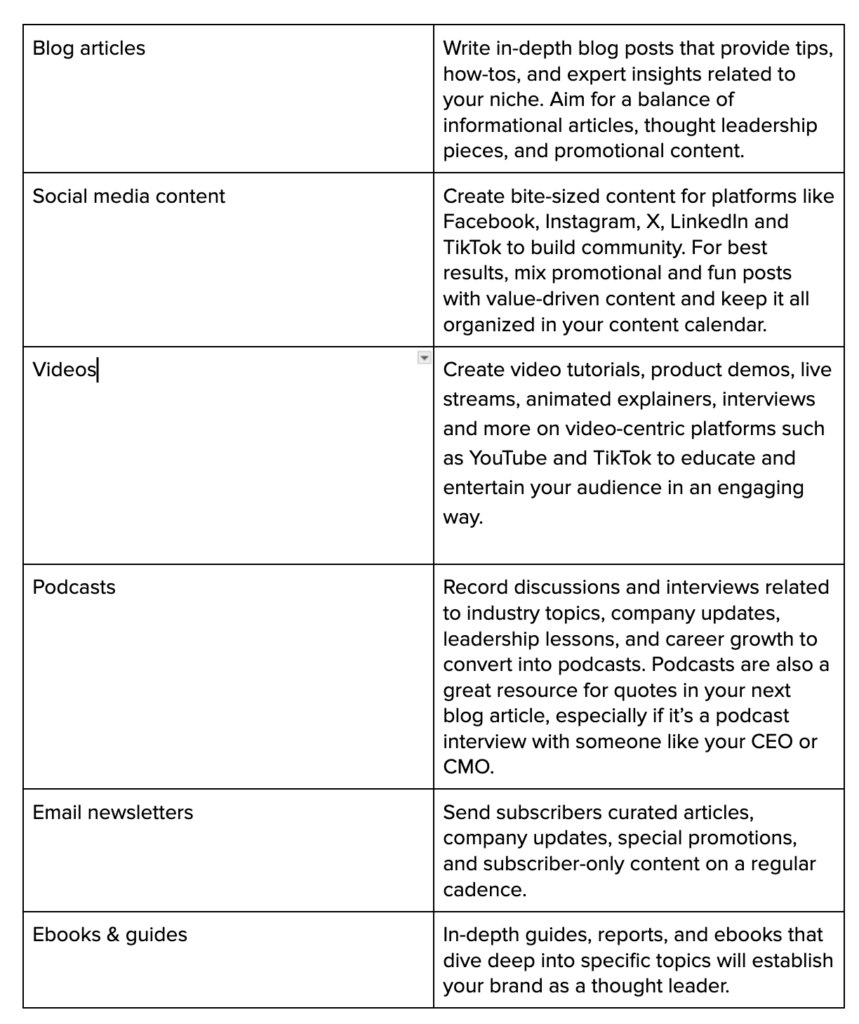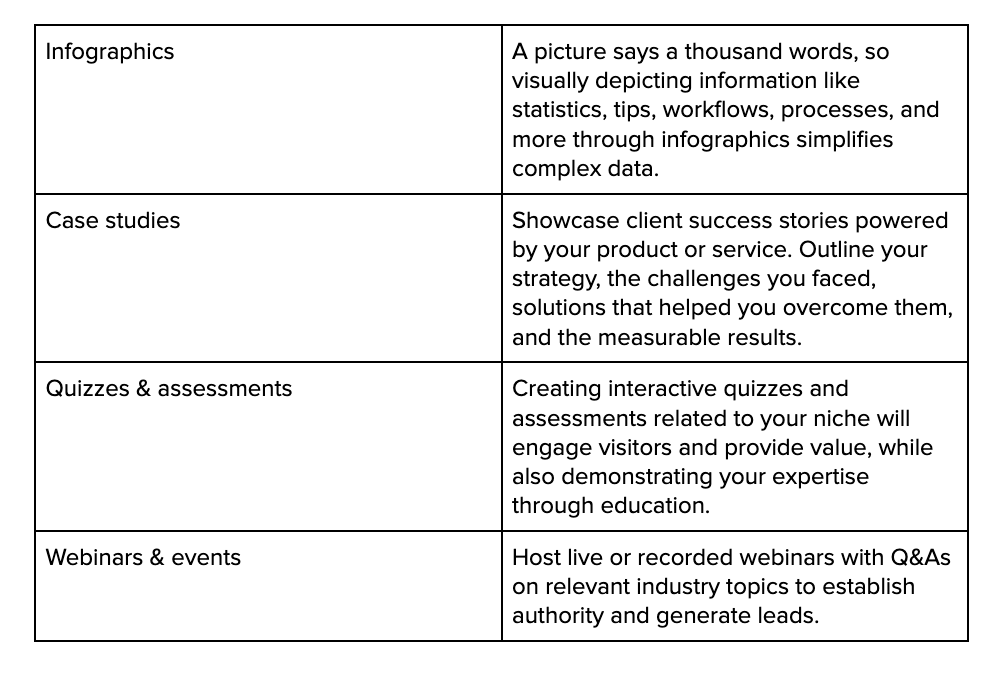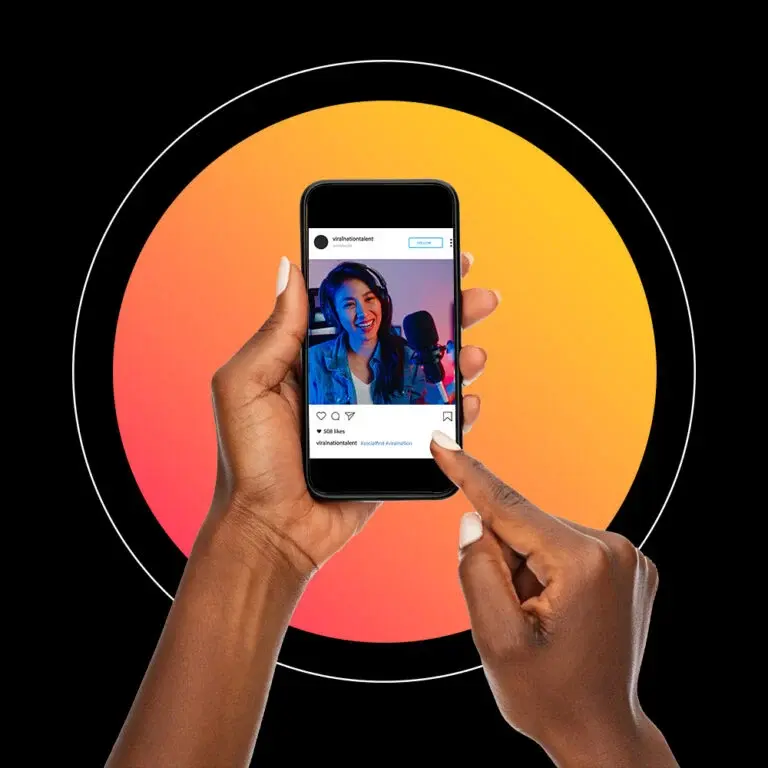Digital content creation is the process of producing written, visual, audio, or any other type of content specifically intended for online distribution. As a marketing manager in the modern world, mastering digital content creation is crucial for engaging target audiences and driving business growth.
When we talk about “digital content,” we’re referring to a broad range of assets, including blog posts, social media content (which can be video, text, or audio), videos, podcasts, infographics, email newsletters, eBooks, webinars, and website content like images and graphics.
Essentially, if it can be accessed and consumed online – it’s digital content. But regardless of the content type, the end goal of creating any kind of digital content is providing value to your target audience and customers.
Why is Digital Content Creation Important?
Here are several key reasons why digital content creation is so important for brands today, and how it can help you as a marketing manager:
1. Meet Customers Where They Are
Consumers are spending more of their time online than ever before, with the average person spending six and a half hours a day on the internet. From social media to search engines and everywhere in between, it’s an unavoidable aspect of modern life – especially if you’re in marketing!
Creating digital content allows you to connect with customers and prospects within their preferred digital platforms and channels, while pinpointing your audience with greater accuracy than traditional advertising that employ a one-size-fits-all approach.
Additionally, many online platforms (from social media apps to content management systems like WordPress) also come with a range of built-in analytics tools to measure and monitor the effectiveness of your campaigns.
2. Increase Brand Awareness & Visibility
Quality content helps build brand authority and trust. The more value your content provides, the more likely your brand will appear in search results for important brand-related keywords. This leads to growing brand awareness and visibility online as users discover, share, and engage with your content.
Creating authoritative content packed with value and insights will raise your brand’s profile immeasurably. Another way digital content can increase brand visibility is through backlinks, which is when other domains find your content so insightful and relevant that they link back to your content on their own websites.
3. Support the Customer Journey
Digital content plays an important role throughout every stage of the customer journey – from initial research and discovery right down to purchase decisions and customer loyalty. Support your prospective customers with content that not only educates but also positions your brand as a helpful resource. Many of the most successful brands create digital content that targets consumers at different stages of the customer journey by addressing specific pain points they often face at each step.
For example, at the awareness stage, focus on creating informative blog posts, videos, or social media content that educates and introduces your brand. At the consideration stage, provide detailed product comparisons, case studies, or testimonials to help potential customers evaluate their options. Finally, at the decision stage, offer incentives such as exclusive discounts or limited-time offers to encourage conversions.
4. Boost Inbound Traffic
When you optimize content for search engines through keywords and SEO best practices, you’ll expand your reach and drive qualified organic traffic to your site. More traffic means more leads and increased sales opportunities.
Research and use keywords relevant to your brand in your content, especially in meta descriptions, titles, and headers. Create a diverse range of content, from blogs and articles to podcasts and videos, to cast a wider net.
5. Improve Conversion Rates
Strategic content helps move prospects down the funnel by building trust, credibility, and relationships. As you nurture leads through content, you can increase conversion rates and the number of customers acquired.
To improve conversion rates, create a clear and compelling call-to-action (CTA) in each piece of content. Make use of landing pages that are optimized for conversion and utilize A/B testing to determine which types of content and which specific elements work best for conversion.
6. Lower Acquisition Costs
As any marketing manager knows, traditional advertising and other outbound marketing tactics can get very expensive. On the other hand, high-quality content brings in targeted traffic through SEO – for free, which will allow you to lower customer acquisition costs over time.
And unlike traditional advertising, digital content is evergreen (for the most part), which means it will stay on your website for consumers to see for a long time to come, regardless of whether you’re currently running a campaign or not.
Start with a solid keyword strategy and SEO. Then, build a library of articles, blogs, videos, and other forms of digital content to ensure your website remains a relevant source of information, which will also reduce your reliance on higher-cost advertising efforts.
7. Build Authority Around Keywords
Creating content centered around relevant keyword phrases helps you rank higher on SERPs (Search Engine Result Pages). Appearing on the first page for your target keywords demonstrates authority and trust in your niche, and it’s a huge competitive advantage because that’s where every business and marketer wants to be.
Research keywords that your audience is likely to search for and create content that responds to those queries. Make sure to include the keywords naturally throughout your content and write long-form articles that are valuable and informative. This will help you establish your authority and improve your ranking on search engines.
8. Cultivate a Loyal Community
Consistent, engaging content will foster a community of potential brand advocates who actively follow and share your content. These loyal brand followers help expand your reach and level of consumer trust through word-of-mouth.
To further encourage community growth, engage with your audience – reply to comments, share user-generated content, ask questions, and show appreciation for your followers. Regularly create interactive content such as polls or live videos to boost engagement and foster a sense of community.
9. Help Your Brand Stand Out
Producing high-quality digital content gives your brand a unique voice that distinguishes it from competitors. Delivering consistent, value-driven content helps you create a memorable presence, keeping your brand top of mind for consumers. Creating engaging visuals, insightful articles, and relatable social media posts establishes an emotional connection with your audience, making your brand more recognizable amongst a sea of competitors.
To further enhance your distinctiveness, ensure your content aligns with your brand’s core values and audience interests. Consistency in messaging and design helps reinforce your identity and builds a lasting impression on both current and potential customers.
10. Build Credibility
Positioning your brand as a knowledgeable authority is crucial, and digital content creation allows you to showcase expertise and build trust within your industry. By sharing valuable insights, helpful tips, and relevant information, you establish credibility – especially when the content solves problems or answers questions your audience cares about.
But it’s not just about building credibility, you must also establish trust and maintain it. To do so, your content must be accurate, consistent, and updated regularly. Engaging your audience through thought leadership, case studies, and customer testimonials further solidifies your credibility and helps strengthen your brand’s reputation over time.
Your 2025 Playbook for Influencer Marketing
Get exclusive insights into scaling influencer campaigns, creating intentional content, and redefini
Important Tips for Creating Digital Content
Now that we’ve covered why digital content creation is imperative for brands, let’s explore some key elements that go into creating effective online content across platforms:
Identify Your Goals and Target Audience
Always begin by establishing crystal clear content goals and knowing your ideal target audience.
Make sure to answer important questions such as “Who are you trying to reach?” and “What action do you want them to take after consuming your content?”. Defining these elements from the start allows you to create content specifically tailored to your audience’s interests, challenges, and needs.
If you’re unsure about what content types to share, conduct user and keyword research to gain insights into topics and formats that your audience prefers. Surveys, interviews, and analytics tools can all help you better understand your audience and create content that addresses their pain points and specific needs.
If your organization doesn’t have the bandwidth or internal resources to execute this task, partnering with a marketing agency like Viral Nation provides you with the knowledge and expertise you need to turn your ideas into content gold.
Choose the Right Content Formats
From short-form social posts to long-form guides and videos, there are countless content formats to choose from. Select the formats that align with your goals, audience preferences, and resources.
Keep in mind that some content formats, such as video, are more labor-intensive and expensive to create than others. For example, a simple text-only post may only take a few minutes to create and post, whereas a 1-minute video could potentially cost thousands of dollars and take weeks to produce (depending on factors including location, production budget, etc.).
But regardless of the content format(s) you choose, don’t put all your eggs in one basket. Instead, aim to diversify your content across multiple formats for the widest possible reach.
Optimize for Search Engines
As mentioned previously, incorporating target keywords in your content naturally will lead to higher rankings on search engine results pages, and writing interesting meta descriptions will compel users to click.
Following SEO best practices like implementing a linking strategy (for both internal and external links) and adding alt text (particularly for images) to boost search visibility will also help you create SEO-friendly content that will ultimately lead to more organic traffic. Consider using SEO tools like Semrush’s AI Writing Assistant to simplify this process.
Craft Compelling Copy
Focus on providing value, solving problems, and engaging your audience in each piece of content. Use an authentic, relatable voice that connects with readers and includes relevant facts, stats, examples, and multimedia to bring your content to life. Even better, back them up with reputable sources to further build trust.
Use storytelling to make your content engaging and relatable. Always provide actionable tips that solve your audience’s problems, and use data, facts, and statistics from reliable sources to validate your points. Use digital writing tools such as Grammarly or Hemingway to refine your copy.
But the most important takeaway here is that compelling copy keeps your audience interested and wanting more, which is essential in generating traffic and interest in your brand.
Promote Across Digital Platforms
Amplify your reach by sharing your content across social media, email, PPC ads, external sites, and more. Repurposing content into multiple formats also helps extend its shelf life and you can syndicate content through RSS feeds and strategic partnerships.
Develop a detailed social media strategy specifying the content you will post, the platform(s) you will use, and the frequency of posts. Use Google Ads for PPC advertising and consider using email marketing automation tools like MailChimp to keep your audience engaged and updated whenever new content gets posted. Utilize RSS feeds and collaborations with influencers or bloggers for content syndication.
Analyze and Refine Over Time
Use analytics to see which topics, formats, and distribution methods perform best. Pay attention to engagement rates, conversions, and organic search traffic. Constantly test and refine your strategy based on insights to improve results.
Google Analytics and other analytics platforms can be used to monitor content performance. Analyze metrics like bounce rate, time on site, conversions, and organic traffic. Perform A/B testing to understand what works best for your audience and hold periodic review meetings with relevant stakeholders to discuss learnings and improvements you can make in your content strategy.
Keep in mind that effective digital content creation is a continuous process that involves refining your strategies over time. Every tip we covered in this section is a vital aspect of digital content creation, and they all work together to create a more powerful digital presence for your brand.
The Content Creation Process
Creating high-quality digital content involves an organized, strategic process. Here is an overview of the key steps involved:
1. Plan Your Content Calendar
A content calendar helps you map out what content you will create and when. It allows you to plan content in advance and helps ensure you remain consistent. It’s ideal to build up a content backlog that you can pull from for one-off posts or when you need to fill out your calendar.
Make sure to outline key topics, formats, columns, and themes in your content calendar and aim to schedule content that aligns with buying cycles and seasonal campaigns.
You can use platforms such as Google Sheets, Microsoft Excel, or a content management system like WordPress, to create and schedule your content calendar. Identify key holidays, events, and product launch dates to start filling out your calendar. Strive for a balance between evergreen content, seasonal content, and promotional materials.
Your 2025 Playbook for Influencer Marketing
Get exclusive insights into scaling influencer campaigns, creating intentional content, and redefini
2. Conduct Keyword Research
Discover the terms and phrases your audience is searching for to inform the topics you write and post about. Keyword research through tools like Google Trends, Semrush, Ahrefs, and Soovle will reveal search volume and competition (i.e. KD, or keyword difficulty). Optimizing for popular search queries drives organic traffic.
Use specified keyword research tools for popular search terms within your industry and use them in your strategy to improve the relevance of your content.
3. Brainstorm & Ideate Topics
Use your research, analytics, current events, and creativity to generate fresh topic ideas that provide value to your audience. Look for concepts that align with your products, resonate with your audience, and have a healthy search volume. Also, consider seasonal or trending themes as well.
To ideate topics, techniques like mind-mapping or online idea generators can help get the juices flowing. You can also monitor social media trends and industry news for inspiration, or even run a survey or poll your audience to find out what they are interested in.
4. Write a Focused Outline
Outline the key points, flow, and structure of your content before writing. Summarize the core focus, themes, headers, and general content structure. Outlining gives direction and clarifies the narrative – which is especially important if you’re not the person writing the article. If that’s the case, this outline can also double as a brief for your writing team.
Start with a captivating headline and then write a summary of your content. Break your subject matter into sub-topics and turn these into headers. Bullet point the main points or ideas under each header.
5. Create a Draft
Compose a complete first draft expanding on your outline. Aim for an authentic, engaging voice that sounds human. Use supporting facts, relevant stories, multimedia, and context to clearly present information to readers.
Allow your initial draft to flow freely without worrying about grammar or spelling. Use storytelling techniques, maintain a conversational tone, and avoid jargon. Incorporate data, case studies or personal stories to back up your points.
6. Optimize SEO Elements
Incorporate target keywords, write a meta description, and include alt text to boost SEO value. Use heading tags appropriately to signal structure, optimize images, and build internal links between related content on your website.
Aim to use your identified keywords two to three times for every 100 words and add alt text to your images that contain important keywords. Also, ensure your target keyword is featured in the title, meta description, and URL.
7. Refine and Edit Your Work
Improve clarity, flow, grammar, and readability through the editing and revision process. Tighten up sentences and transitions, check for spelling errors, and have a peer review your content with a fresh perspective to further maximize quality.
Use editing platforms like Grammarly to check spelling and grammar, and ensure each paragraph and heading transitions smoothly to the next one.
If you’re feeling stuck, consider setting your work aside for a moment and then return to it with a different perspective or new ideas.
8. Add Visuals & Media
Include engaging visuals like photos, graphics, charts, videos, or illustrations that complement the text and enhance user experience. Visuals help improve the user experience by breaking up blocks of text, reinforcing key points, and boosting engagement.
Use tools like Canva and Piktochart to design professional graphics and ensure your captions and alt text relate to the visuals. Use stock images if you can’t create your own, but be sure to adhere to copyright rules.
9. Publish and promote content
Share your final piece across your owned platforms to maximize visibility. Then amplify reach by sharing your content across social channels, email, and through influencer marketing. Consider paid promotions as well.
Publish your content at optimal times when your audience is most active online, schedule your posts on social media, and send emails announcing your new content to your subscriber list.
10. Track performance & optimize
Analyze metrics like reach, clicks, engagement, leads, and sales to see what content is resonating with your audience. Use these insights to create more of this type of content, and refine the content that isn’t working to continually improve results.
Platforms like Google Analytics and Hootsuite can help monitor your content’s performance while identifying areas to tweak.
Going through this content creation process will help you stay organized and strategic in your digital content efforts. Remember, these steps are not one-off actions, but rather part of a cycle to consistently create, promote, monitor, and improve your content to achieve the best results.
Digital Content Types and Best Practices
There are endless possibilities when it comes to creating value-driven digital content. Here are just a few specific types of content you can create as a marketing manager to engage audiences:


The key is to consistently create content that is tailored to each platform your audience uses. Test different formats, analyze performance, and refine your strategy over time. The more value your content provides, the more it will attract and convert your ideal customers.
Your 2025 Playbook for Influencer Marketing
Get exclusive insights into scaling influencer campaigns, creating intentional content, and redefini
Bonus Tips for Digital Content Creation
Here are some final tips to ensure the content you create succeeds in meeting your business goals:
- Focus on quality over quantity – One phenomenal piece of content is worth more than 10 mediocre ones. Prioritize substance over churning out countless low-grade articles.
- Adapt content for each platform – Tailor content for where it will live. An effective Facebook post differs from a YouTube video script. Match the format.
- Always create for your audience first – Skip self-promotional content that only boasts about your product. Nobody will care if you make it all about you. Instead, put the reader’s interests, needs, and perspective first.
- Have a clear CTA – Every piece of content should guide your audience toward a specific action, whether to download an ebook, schedule a call, sign up for a demo, or purchase a product.
- Get creative and diversify formats – Explore different content formats beyond the blog post to provide variety and visual content. Podcasts, videos, and interactive content can all engage visitors.
- Optimize technical elements for each platform – Follow best practices for image sizes, aspect ratios, keywords, captions, character limits, and meta descriptions.
- Promote your content across channels – Don’t just set it and forget it. Share your content through email, social media, and paid ads for amplified reach.
- Analyze performance and double down on what works – Use analytics to identify your best-performing content. Then create more of that type of content to maximize impact.
Drive ROI with Viral Nation
To amplify your brand’s voice through the power of digital content, Viral Nation’s Social Content Studio brings together strategic planning, creative production, and data-driven insights. Whether you’re leveraging AI-powered intelligence for creator collaborations or producing in-house content, we ensure your messaging is not only engaging but also aligns with the latest trends. Discover how our tailored social-first approach can fuel your brand’s growth with storytelling that resonates across platforms.






.png?width=300&height=300&name=Minimal%20Photocentric%20Productivity%20Blog%20Banner%20(3).png)